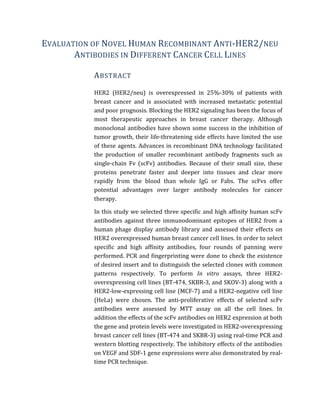
Thesis - Abstract
- 1. EVALUATION OF NOVEL HUMAN RECOMBINANT ANTI-‐HER2/NEU ANTIBODIES IN DIFFERENT CANCER CELL LINES ABSTRACT HER2 (HER2/neu) is overexpressed in 25%-‐30% of patients with breast cancer and is associated with increased metastatic potential and poor prognosis. Blocking the HER2 signaling has been the focus of most therapeutic approaches in breast cancer therapy. Although monoclonal antibodies have shown some success in the inhibition of tumor growth, their life-‐threatening side effects have limited the use of these agents. Advances in recombinant DNA technology facilitated the production of smaller recombinant antibody fragments such as single-‐chain Fv (scFv) antibodies. Because of their small size, these proteins penetrate faster and deeper into tissues and clear more rapidly from the blood than whole IgG or Fabs. The scFvs offer potential advantages over larger antibody molecules for cancer therapy. In this study we selected three specific and high affinity human scFv antibodies against three immunodominant epitopes of HER2 from a human phage display antibody library and assessed their effects on HER2 overexpressed human breast cancer cell lines. In order to select specific and high affinity antibodies, four rounds of panning were performed. PCR and fingerprinting were done to check the existence of desired insert and to distinguish the selected clones with common patterns respectively. To perform In vitro assays, three HER2-‐ overexpressing cell lines (BT-‐474, SKBR-‐3, and SKOV-‐3) along with a HER2-‐low-‐expressing cell line (MCF-‐7) and a HER2-‐negative cell line (HeLa) were chosen. The anti-‐proliferative effects of selected scFv antibodies were assessed by MTT assay on all the cell lines. In addition the effects of the scFv antibodies on HER2 expression at both the gene and protein levels were investigated in HER2-‐overexpressing breast cancer cell lines (BT-‐474 and SKBR-‐3) using real-‐time PCR and western blotting respectively. The inhibitory effects of the antibodies on VEGF and SDF-‐1 gene expressions were also demonstrated by real-‐ time PCR technique.
- 2. Twenty clones were isolated against each epitope. PCR and fingerprinting results revealed that the isolated clones against each epitope have the insert and also their patterns are the same. One clone against each epitope was selected for further investigations. The MTT results showed that the scFvs, separately and in combination, are capable of inhibiting the cell growth of HER2-‐positive cell lines significantly. These inhibitory effects on BT-‐474, SKBR-‐3, and SKOV-‐3 cell lines were 80%, 75%, and 80% respectively whereas lower inhibitory effects were observed in MCF-‐7 cell line (15%) and no effect was observed in HeLa cell line. Furthermore combination of three selected scFvs significantly inhibited the cell growth more efficient than scFvs alone. The results of real-‐time PCR and western blotting demonstrated that our selected scFvs inhibit the expression of HER2 at both the gene and protein levels and this inhibitory effect was significantly more effective when the cells were treated with combination of all three scFv antibodies. Also, the obtained results from real-‐time PCR indicated that the selected scFvs are capable of down-‐regulating the VEGF gene expression separately and in combination. Moreover scFv-‐II and combination of three scFv antibodies reduced the expression level of SDF-‐1 mRNA in HER2-‐ positive breast cancer cell lines. The significant inhibitory effects of the selected scFvs on HER2-‐ positive breast cancer cell lines offer the potential application of these selected libraries in the treatment of cancers overexpressing HER2. Down-‐regulation of HER2 in both the gene and protein levels induced by the selected scFvs is a good criterion for the selection of these small antibodies for effective treatment in cancer immunotherapy of HER2-‐positive breast cancer. Moreover the anti-‐angiogenic effects of these high affinity libraries showed by reduction in VEGF gene expression make these antibodies more attractive for anti-‐cancer therapy. According to the scFvs combination assays, we suggest the use of these scFvs in combinations form in order to down-‐regulate HER2, VEGF, and SDF-‐1 simultaneously to obtain more efficient outcome in breast cancer immunotherapy.